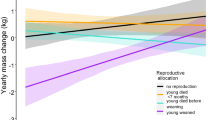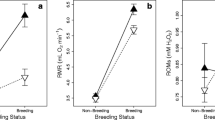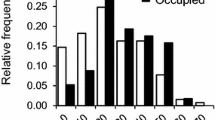Abstract
The Trivers-Willard hypothesis predicts that, in polygynous and sexually dimorphic mammals, mothers able to provide a large amount of care should produce more sons. Tests of this prediction, however, have generated equivocal results, possibly because multiple factors, including environmental conditions, simultaneously influence progeny sex ratio. We tested the influence of maternal mass, condition, size, previous reproduction and age class on offspring sex ratio in two populations of eastern grey kangaroos (Macropus giganteus). In one population, heavier and taller mothers produced more sons than did lighter mothers, but maternal condition had no effect on progeny sex ratio. Primiparous females, however, produced an even offspring sex ratio despite being smaller than multiparous females. A strong year effect on progeny sex ratio suggested a likely effect of environmental conditions. In the second population, none of the variables tested influenced progeny sex ratio. Different environmental conditions between the two populations could partly explain these results. Because maternal size and mass likely correlate with reproductive potential, we suggest that our results support the Trivers-Willard hypothesis, but other variables likely also influence progeny sex ratio.

Similar content being viewed by others
References
Baeta R, Bélisle M, Garant D (2012) Importance of breeding season and maternal investment in studies of sex-ratio adjustment: a case study using tree swallows. Biol Lett 8:401–404
Bates DM, Maechler M, Dai B (2014) lme4: Linear mixed-effects models using Eigen and S4 classes, http://lme4.r-forge.r-project.org/
Blanchard P, Festa-Bianchet M, Gaillard J-M, Jorgenson JT (2005) Maternal condition and offspring sex ratio in polygynous ungulates: a case study of bighorn sheep. Behav Ecol 16:274–279
Cameron EZ (2004) Facultative adjustment of mammalian sex ratios in support of the trivers–Willard hypothesis: evidence for a mechanism. Proc R Soc Lond B 271:1723–1728
Cameron EZ, Linklater WL, Stafford KJ, Veltman CJ (1999) Birth sex ratios relate to mare condition at conception in Kaimanawa horses. Behav Ecol 10:472–475
Caughley G, Kean R (1964) Sex ratios in marsupial pouch young. Nature 204:491
Clark AB (1978) Sex ratio and local resource rompetition in a prosimian primate. Science 201:163–165
Clutton-Brock T (1991) The evolution of parental care. Princeton University Press, Princeton
Clutton-Brock TH, Iason GR (1986) Sex ratio variation in mammals. Q Rev Biol 61:339–374
Clutton-Brock TH, Albon SD, Guinness FE (1985) Parental investment and sex differences in juvenile mortality in birds and mammals. Nature 313:131–133
Clutton-Brock TH, Albon SD, Guinness FE (1986) Great expectations: dominance, breeding success and offspring sex ratios in red deer. Anim Behav 34:460–471
Cockburn A (1990) Sex-ratio variation in marsupials. Aust J Zool 37:467–479
Cockburn A, Legge S, Double MC (2002) Sex ratios in birds and mammals: can the hypotheses be disentangled? In: Hardy I (ed) Sex ratios : concepts and research methods. Cambridge University Press, New York, pp 266–286
Coulson G, MacFarlane AM, Parsons SE, Cutter J (2006) Evolution of sexual segregation in mammalian herbivores: kangaroos as marsupial models. Aust J Zool 54:217–224
Coulson G, Cripps JK, Wilson ME (2014) Hopping down the main street: eastern grey kangaroos at home in an urban matrix. Animals 4:272–291
Davis NE, Forsyth DM, Coulson G (2010) Facilitative interactions between an exotic mammal and native and exotic plants: hog deer (Axis porcinus) as seed dispersers in south-eastern Australia. Biol Invasions 12:1079–1092
Festa-Bianchet M (1996) Offspring sex ratio studies of mammals: does publication depend upon the quality of the research or the direction of the results? Ecoscience 3:42–44
Fisher RA (1958) The genetical theory of natural selection. Dover Publications, New York
Gélin U, Wilson ME, Coulson GC, Festa-Bianchet M (2013) Offspring sex, current and previous reproduction affect feeding behaviour in wild eastern grey kangaroos. Anim Behav 86:885–891
Gélin U, Wilson ME, Cripps J, Coulson GC, Festa-Bianchet M (2015) Experimental manipulation of female reproduction demonstrates its fitness costs in kangaroos. J Anim Ecol 84:239–248
Glass R (2013) Assessing the precision and accuracy of Distance sampling for estimating the abundance of eastern grey kangaroos. M.Sc. thesis, Dept. of Zoology, Univ Melbourne
Green AJ (2001) Mass/length residuals: measures of body condition or generators of spurious results? Ecology 82:1473–1483
Green B, Merchant J, Newgrain K (1988) Milk consumption and energetics of growth in pouch young of the tammar wallaby, Macropus eugenii. Aust J Zool 36:217–227
Hamilton WD (1967) Extraordinary sex ratios. Science 156:477–488
Hewison AJM, Gaillard J-M (1999) Successful sons or advantaged daughters? the trivers–Willard model and sex-biased maternal investment in ungulates. Trends Ecol Evol 14:229–234
Isaac JL, Krockenberger AK, Johnson CN (2005) Adaptive sex allocation in relation to life-history in the common brushtail possum, Trichosurus vulpecula. J Anim Ecol 74:552–558
Jaremovic R, Croft D (1991) Social organization of the eastern grey kangaroo (Macropodidae, Marsupialia) in southeastern New South Wales. I. Groups and group home ranges. Mammalia 55:169–186
Jarman P (1983) Mating system and sexual dimorphism in large terrestrial, mammalian herbivores. Biol Rev 58:485–520
Jarman PJ (1991) Social behavior and organization in the Macropodoidea. Adv Stud Behav 20:1–50
Johnson C, Jarman P (1983) Geographical variation in offspring sex ratios in kangaroos. Search 14:152–154
Johnson CN, Ritchie EG (2002) Adaptive biases in offspring sex ratios established before birth in a marsupial, the common brushtail possum Trichosurus vulpecula. Behav Ecol 13:653–656
King WJ, Wilson ME, Allen T, Festa-Bianchet M, Coulson G (2011) A capture technique for free-ranging eastern grey kangaroos (Macropus giganteus) habituated to humans. Aust Mammal 33:47–51
Kruuk LE, Clutton-Brock TH, Albon SD, Pemberton JM, Guinness FE (1999) Population density affects sex ratio variation in red deer. Nature 399:459–461
Le Cren E (1951) The length-weight relationship and seasonal cycle in gonad weight and condition in the perch (Perca fluviatilis). J Anim Ecol 20:201–219
Maguire G, Ramp D, Coulson G (2006) Foraging behaviour and dispersion of eastern grey kangaroos (Macropus giganteus) in an ideal free framework. J Zool 268:261–269
Martin JGA, Festa-Bianchet M (2011) Sex ratio bias and reproductive strategies: what sex to produce when? Ecology 92:441–449
Miller EJ, Eldridge MDB, Cooper DW, Herbert CA (2010) Dominance, body size and internal relatedness influence male reproductive success in eastern grey kangaroos (Macropus giganteus). Reprod Fert Develop 22:539–549
Mysterud A, Yoccoz NG, Stenseth NCHR, Langvatn R (2000) Relationships between sex ratio, climate and density in red deer: the importance of spatial scale. J Anim Ecol 69:959–974
Peig J, Green AJ (2009) New perspectives for estimating body condition from mass/length data: the scaled mass index as an alternative method. Oikos 118:1883–1891
Peig J, Green AJ (2010) The paradigm of body condition: a critical reappraisal of current methods based on mass and length. Funct Ecol 24:1323–1332
Pinheiro JC, Bates DM (2000) Mixed effects models in S and S-PLUS. Springer, New York
Poole W (1975) Reproduction in the two species of grey kangaroos, Macropus giganteus Shaw and M. fuliginosus (Desmarest). II. Gestation, parturition and pouch life. Aust J Zool 23:333–353
Poole W, Carpenter S, Wood J (1982) Growth of grey kangaroos and the reliability of age determination from body measurements I. The eastern grey kangaroo, Macropus giganteus. Wildlife Res 9:9–20
Robert KA, Braun S (2012) Milk composition during lactation suggests a mechanism for male biased allocation of maternal resources in the tammar wallaby (Macropus eugenii). PLoS One 7:e51099
Robert KA, Schwanz LE (2011) Emerging sex allocation research in mammals: marsupials and the pouch advantage. Mammal Rev 41:1–22
Robert KA, Schwanz LE, Mills HR (2010) Offspring sex varies with maternal investment ability: empirical demonstration based on cross-fostering. Biol Lett 6:242–245
Schulte-Hostedde AI, Zinner B, Millar JS, Hickling GJ (2005) Restitution of mass-size residuals: validating body condition indices. Ecology 86:155–163
Schwanz LE, Robert KA (2014) Proximate and ultimate explanations of mammalian sex allocation in a marsupial model. Behav Ecol Sociobiol 68:1–12
Sheldon BC, Stuart A, West S (2004) Maternal dominance, maternal condition, and offspring sex ratio in ungulate mammals. Am Nat 163:40–54
Silk JB (1983) Local resource competition and facultative adjustment of sex ratios in relation to competitive abilities. Am Nat 121:56–66
Stuart-Dick RI, Higginbottom KB (1989) Strategies of parental investment in Macropodoids. In: Grigg GC, Hume ID, Jarman PJ (eds) Kangaroo. Wallabies and Rat-Kangaroos. Surrey Beatty and Sons, Sydney, pp 571–592
Sunnucks P, Taylor AC (1997) Sex of pouch young related to maternal weight in Macropus eugenii and M. parma (Marsupialia: Macropodidae). Aust J Zool 45:573–578
Trivers RL, Willard DE (1973) Natural selection of parental ability to vary the sex ratio of offspring. Science 179:90–92
Weladji RB, Holand Ø (2003) Sex ratio variation in reindeer Rangifer tarandus: a test of the extrinsic modification hypothesis. Wildlife Biol 9:29–36
West S (2009) Sex Allocation. Princeton University Press, Princeton
Wilson ME, Coulson G, Shaw G, Renfree MB (2013) Deslorelin implants in free-ranging female eastern grey kangaroos (Macropus giganteus): mechanism of action and contraceptive efficacy. Wildlife Res 40:403–412
Zuur AF, Ieno EN, Walker NJ, Saveliev AA, Smith GM (2009) Mixed effects models and extensions in ecology with R. Springer, New York
Acknowledgments
We are grateful to the contribution of students and field assistants over the years, especially E. Rioux Paquette, W. King, U. Gélin, A. Mackay, T. Allen, M. Wilson, S. Garnick and J. Cripps. This research was supported financially by the Natural Sciences and Engineering Research Council of Canada (NSERC), the Australian Research Council (ARC) Linkage Program, the Ministère de l’Éducation, du Loisir et du Sport of Québec (MELS), the Holsworth Wildlife Research Endowment, Parks Victoria and the Université de Sherbrooke. We appreciate the logistic support of Parks Victoria and the Anglesea Golf Club.
Ethical standards
All procedures involving animals were in accordance with the ethical standards of the institution or practice at which the studies were conducted, as authorized by The University of Melbourne Animal Ethics Committee and by the Université de Sherbrooke Animal Care Committee, affiliated with the Canadian Council on Animal Care.
Author information
Authors and Affiliations
Corresponding author
Additional information
Communicated by A. I. Schulte-Hostedde
Electronic supplementary material
Below is the link to the electronic supplementary material.
ESM 1
(DOCX 197 kb)
Rights and permissions
About this article
Cite this article
Le Gall-Payne, C., Coulson, G. & Festa-Bianchet, M. Supersize me: heavy eastern grey kangaroo mothers have more sons. Behav Ecol Sociobiol 69, 795–804 (2015). https://doi.org/10.1007/s00265-015-1896-y
Received:
Revised:
Accepted:
Published:
Issue Date:
DOI: https://doi.org/10.1007/s00265-015-1896-y




